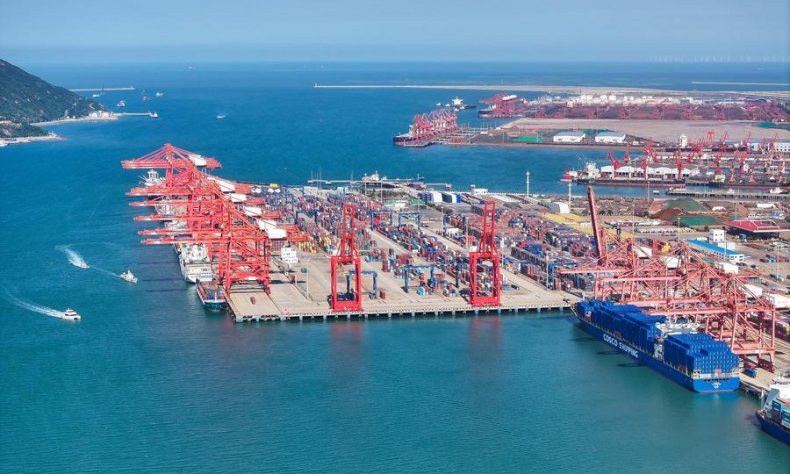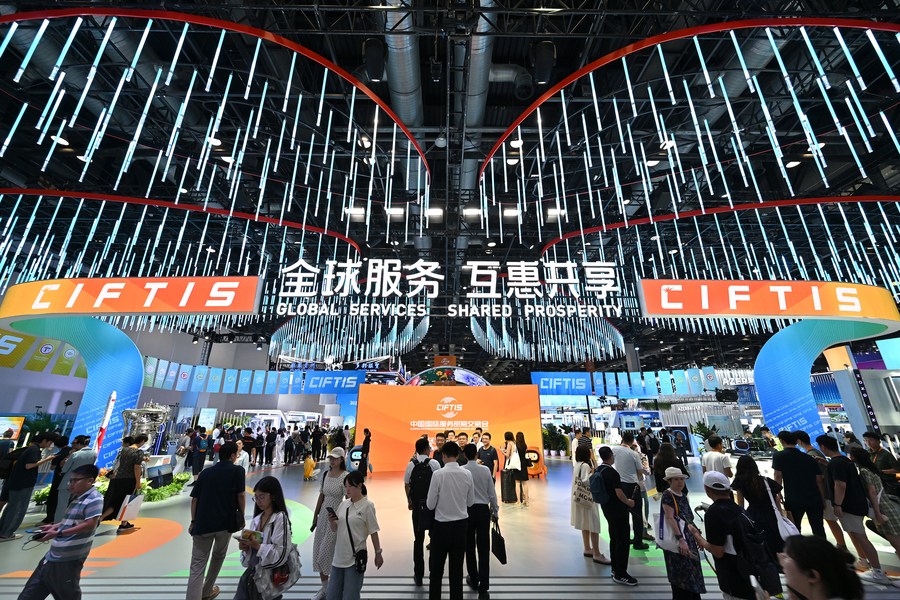Opening Up: From China to the World

The Chinese path to modernization is not just about developing itself but also about benefiting the world at large.
“Opening up is a defining feature of Chinese modernization,” according to the Resolution of the Central Committee of the Communist Party of China (CPC) on Further Deepening Reform Comprehensively to Advance Chinese Modernization, adopted at the Third Plenary Session of the 20th CPC Central Committee on July 18.
The session made special arrangements for further opening up. “We must remain committed to the basic state policy of opening to the outside world and continue to promote reform through opening up. Leveraging the strengths of China’s enormous market, we will enhance our capacity for opening up while expanding international cooperation and develop new institutions for a higher-standard open economy,” the resolution said.
Contributing to world development
Since reform and opening up began 46 years ago, China has made tremendous contribution to world peace and development through its own development, including economic, technological, cultural and environmental contributions. China’s contribution to global economic growth averaged 38.6 percent from 2013 to 2021, exceeding the combined contribution of the Group of Seven (G7) countries. China is the country with the largest increase in forest resources and the largest area of artificial afforestation in the world, contributing a quarter of the world’s greening in the past 20 years. The stable and sound development of the Chinese economy adds certainty to the uncertain world economy.
The contribution of the Chinese economy to the world economy is reflected not only in quantity, but also in quality. It is the primary driving force and important engine for promoting world economic growth, and has won widespread recognition from the international community. In a public opinion survey conducted by the Academy of Contemporary China and World Studies in 25 countries, respondents highly praised China’s contribution to promoting world economic development, with over 93 percent believing that China contributes to global common development through its own development.
The statements in the resolution adopted at the third plenary session, such as “reform and opening up are an ongoing endeavor,” “move faster to create a new pattern of development,” “expand institutional opening up,” and “optimize the environment for opening up and cooperation,” are becoming hot topics in the international community. Yu Jie, a senior research fellow at Chatham House in the UK, said the third plenary session has pointed the direction for China’s economic growth strategy for the next decade, marking a significant shift in China’s growth model from pursuing nominal growth rates to building an innovation-driven resilient economy and driving China to lead future industries globally.

Chinese modernization
The opening-up drive goes beyond China to benefit the world. At present, global changes of a like not seen in a century are accelerating, the world situation is intertwined with turmoil, protectionism is prevalent, and global peace and development are facing new threats and challenges. As the largest developing country in the world, China has not followed the old path of some Western countries and has always been a builder of world peace, a contributor to global development and a guardian of the international order. The Chinese path to modernization is not just about developing itself but also about benefiting the world at large. Shakeel Ramay, CEO of the Asian Ecological Civilization Research and Development Institute of Pakistan, believes that the third plenary session highlighted the world view contained in CPC Central Committee General Secretary Xi Jinping’s ideas on development, because the goal of the Chinese path to modernization is not monolithic, but multifaceted, including China’s peaceful development, creating opportunities for the world, common prosperity and win-win cooperation.
China has remained committed to the basic state policy of opening to the outside world and promoted high-standard opening up. General Secretary Xi has emphasized on multiple occasions that China’s door of opening up will only open wider, and will never be closed, and “China will remain an important opportunity for the world’s development. Our door is wide open to anyone who wants to engage in cooperation with us.” The Business Confidence Survey 2023/24, released by the German Chamber of Commerce in China, shows that over 90 percent of the surveyed German companies plan to continue to establish themselves in the Chinese market, viewing China as a vast and growing market. According to the 2023 Survey on Business Conditions of Japanese-Affiliated Companies Overseas by the Japan External Trade Organization, over 90 percent of the surveyed enterprises chose “expansion” or “to maintain the current status” regarding their business development direction in China in the next one to two years.
The notion that China’s “overcapacity harms the global market” is a complete fallacy. Building a “small courtyard with high walls” to shield against China will only result in a “multi-party loss” scenario. Is the global supply of new energy capacity greater than demand? The answer is “no.” Taking electric vehicles (EVs) as an example. Most countries in the Global South are formulating new automotive policies, actively fulfilling their commitments to address climate change, and encouraging the use of EVs as an important means of reducing emissions in transportation. According to the International Energy Agency, the global sales volume of EVs will reach almost 45 million units in 2030, and the demand for solar photovoltaic capacity will also increase significantly. China’s production remains far lower than the world’s demand. What China provides to the world is advanced production capacity, not excess capacity.
Institutional opening up
The third plenary session provides an important window for the international community to observe China’s promotion of high-quality development and high-standard opening up in the new era. China will steadily expand its institutional opening up and promote alignment with high-standard international economic and trade rules. It will take the initiative in expanding opening up, improve the mechanisms for high-quality cooperation under the Belt and Road Initiative, and bring more opportunities to the world.

First, China’s institutional opening up will continue to offer market opportunities. The overall objective of further deepening reform comprehensively proposes that by 2035, we will have finished building a high-standard socialist market economy in all respects and further improve the system of socialism with Chinese characteristics. China has the advantages of the demand created by its super large market and the supply of a complete industrial system. Bloomberg News reported that China’s pursuit of technology-driven high-quality growth has achieved results—the GDP related to hi-tech industries expanded 12 percent on average between 2018 and 2023.
Second, China’s institutional opening up will continue to offer investment opportunities. The third plenary session emphasized the need to “channel various types of advanced production factors toward the development of new quality productive forces.” China will accelerate the establishment of the new development paradigm featuring dual circulation, in which domestic and overseas markets reinforce each other, with the domestic market as the mainstay. New quality productive forces enhance the endogenous driving force of domestic circulation, and significantly improves the comprehensive competitiveness of China’s industrial development. Through high-standard opening up and deep participation in global industrial division of labor and cooperation, mutual promotion and progress between domestic and international circulation can be achieved, thus continuously developing a new model for human progress.
Third, China’s institutional opening up will continue to offer growth opportunities. Throughout the history of human development, China has adhered to the correct direction of economic globalization, injecting more certainty and positive energy into the turbulent and intertwined world. China will expand its unilateral opening up to the least developed countries, deepen the reform of its foreign-aid systems and mechanisms, share the successful experience gained on its path to modernization, and provide valuable references and lessons for other developing countries. Give people fish and you feed them for a day. Teach them how to fish and you feed them for a lifetime. Many African countries have expressed their eagerness to seize the historic opportunity of China’s economic transformation and upgrading, and become a priority recipient of China’s industrial and production capacity transfer. China will drive economic growth through supply innovation, share the achievements of industrial advancement, and promote the realization of a world modernization characterized by peaceful development, mutually beneficial cooperation and common prosperity.
The author is president of and a research fellow at the Academy of Contemporary China and World Studies.
 Facebook
Facebook
 Twitter
Twitter
 Linkedin
Linkedin
 Google +
Google +










